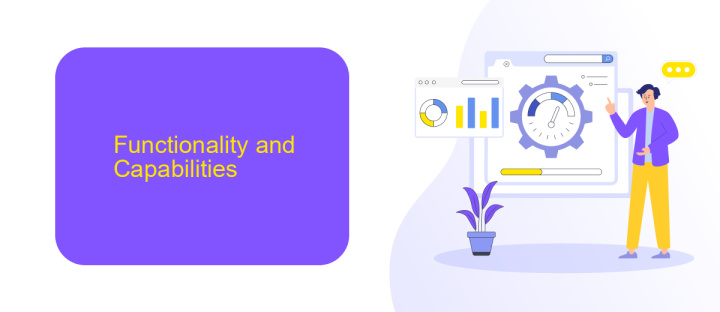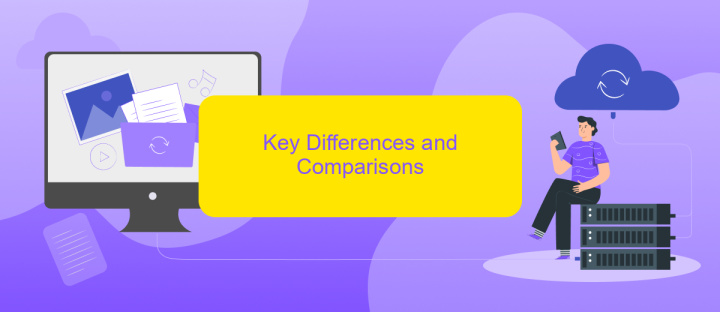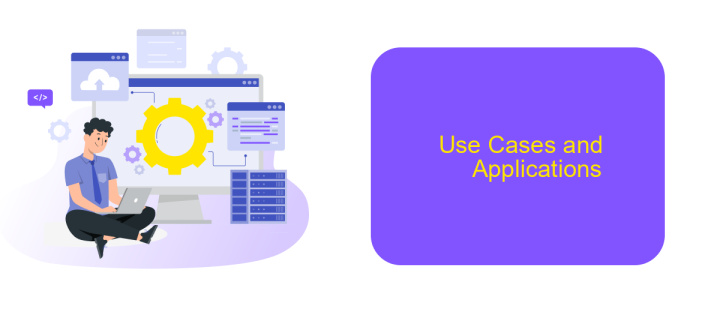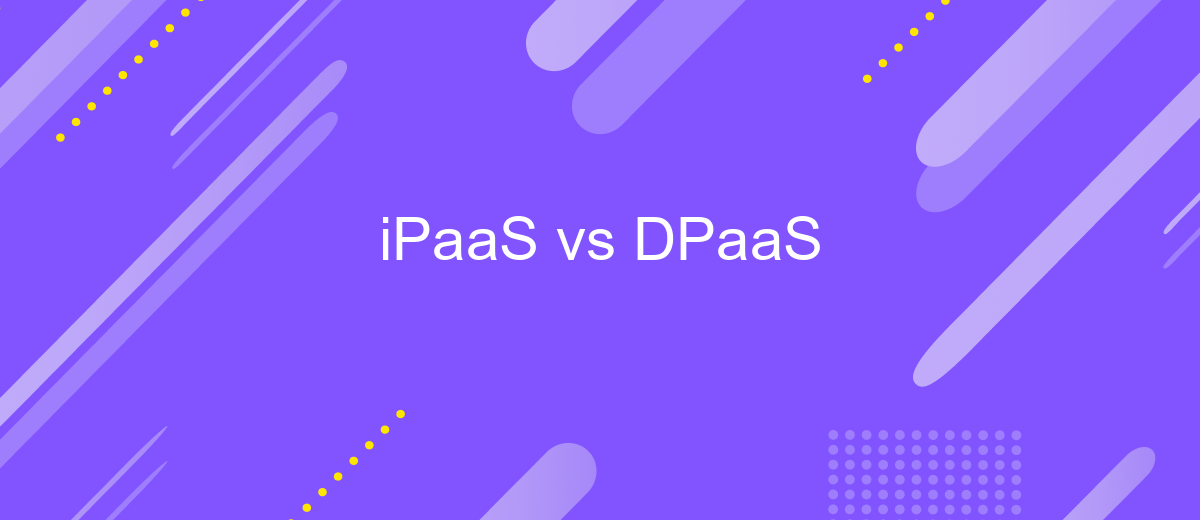iPaaS vs DPaaS
In the rapidly evolving landscape of cloud computing, businesses are increasingly turning to integration platforms as a service (iPaaS) and data platforms as a service (DPaaS) to streamline operations and enhance data management. This article delves into the key differences, benefits, and use cases of iPaaS and DPaaS, helping organizations make informed decisions on which solution best fits their needs.
Introduction
In today's rapidly evolving digital landscape, businesses are increasingly relying on cloud-based solutions to streamline their operations and enhance productivity. Two prominent approaches that facilitate these goals are Integration Platform as a Service (iPaaS) and Data Platform as a Service (DPaaS). These platforms offer distinct functionalities that cater to different aspects of data management and integration.
- iPaaS: Focuses on integrating various applications and services.
- DPaaS: Specializes in managing and analyzing large volumes of data.
Understanding the differences and synergies between iPaaS and DPaaS is crucial for businesses looking to optimize their digital strategies. For instance, services like ApiX-Drive can simplify the integration process by providing a user-friendly interface for connecting various applications. This not only saves time but also reduces the complexity involved in managing multiple systems. By leveraging the strengths of both iPaaS and DPaaS, organizations can achieve a more cohesive and efficient operational framework.
Functionality and Capabilities

iPaaS (Integration Platform as a Service) offers a comprehensive suite of tools designed to facilitate seamless integration between various applications and services. It enables businesses to connect disparate systems, automate workflows, and manage data flows efficiently. Platforms like ApiX-Drive play a crucial role in this ecosystem by providing user-friendly interfaces and pre-built connectors that simplify the integration process, reducing the need for extensive coding and technical expertise.
On the other hand, DPaaS (Data Platform as a Service) focuses primarily on data management, storage, and analytics. It offers capabilities for data ingestion, transformation, and visualization, making it easier for organizations to derive actionable insights from their data. DPaaS platforms often come with robust security features, scalability options, and support for various data sources, ensuring that businesses can handle large volumes of data effectively. While iPaaS emphasizes connectivity and automation, DPaaS is centered around data-centric functionalities, providing a solid foundation for data-driven decision-making.
Key Differences and Comparisons

When comparing iPaaS (Integration Platform as a Service) and DPaaS (Data Platform as a Service), it's essential to understand their core functionalities and use cases. iPaaS primarily focuses on integrating various applications and services, allowing seamless data flow between them. On the other hand, DPaaS is designed to manage, store, and analyze large volumes of data, providing robust data management capabilities.
- Purpose: iPaaS is used for application and service integration, while DPaaS is focused on data management and analytics.
- Data Handling: iPaaS facilitates real-time data integration, whereas DPaaS handles large-scale data storage and batch processing.
- Flexibility: iPaaS offers flexibility in connecting various cloud and on-premises applications. DPaaS provides flexibility in data storage options and advanced analytics tools.
- Use Case: iPaaS is ideal for businesses needing to streamline workflows between different software, such as using ApiX-Drive for automated integrations. DPaaS is suitable for organizations requiring comprehensive data analysis and storage solutions.
In summary, while both iPaaS and DPaaS offer unique advantages, their applications are distinct. iPaaS excels in integrating disparate systems, enhancing operational efficiency, and automating workflows. Conversely, DPaaS is invaluable for organizations needing to manage extensive datasets and perform complex data analytics. Choosing between the two depends on the specific needs and goals of your business.
Use Cases and Applications

iPaaS (Integration Platform as a Service) and DPaaS (Data Platform as a Service) offer versatile solutions for modern businesses. iPaaS primarily focuses on integrating various applications and services, while DPaaS emphasizes data management and analytics. These platforms are crucial for businesses aiming to streamline operations and enhance data-driven decision-making.
ApiX-Drive is a notable example of an iPaaS solution that facilitates seamless integration between different applications. It allows businesses to automate workflows without the need for extensive coding knowledge, thus saving time and resources. On the other hand, DPaaS platforms provide robust data storage, processing, and analytics capabilities, making them ideal for handling large volumes of data.
- Automating marketing and sales processes via iPaaS solutions like ApiX-Drive
- Centralizing data from multiple sources for comprehensive analytics using DPaaS
- Enhancing customer experience through integrated CRM systems
- Streamlining supply chain management with real-time data integration
Both iPaaS and DPaaS are essential tools for businesses looking to stay competitive in a data-driven world. By leveraging these platforms, companies can achieve greater efficiency, improve data accuracy, and make more informed decisions. ApiX-Drive, in particular, stands out for its user-friendly interface and extensive integration capabilities, making it a valuable asset for any organization.
Conclusion
In conclusion, both iPaaS and DPaaS offer unique advantages depending on the specific needs of an organization. iPaaS is ideal for businesses looking to streamline their integration processes across various applications and services, providing a unified platform for seamless connectivity. On the other hand, DPaaS focuses on data management, security, and accessibility, making it a suitable choice for organizations that prioritize data governance and compliance.
Choosing between iPaaS and DPaaS ultimately depends on your organizational goals and requirements. For instance, if your primary objective is to integrate multiple systems efficiently, a service like ApiX-Drive can be highly beneficial. ApiX-Drive simplifies the integration process, allowing businesses to connect various applications without extensive coding or technical expertise. By leveraging the right platform, companies can enhance their operational efficiency and achieve their strategic objectives more effectively.
FAQ
What is the main difference between iPaaS and DPaaS?
When should a business consider using iPaaS over DPaaS?
Can iPaaS handle data processing tasks?
What are some common use cases for iPaaS?
How does ApiX-Drive facilitate the use of iPaaS?
Routine tasks take a lot of time from employees? Do they burn out, do not have enough working day for the main duties and important things? Do you understand that the only way out of this situation in modern realities is automation? Try Apix-Drive for free and make sure that the online connector in 5 minutes of setting up integration will remove a significant part of the routine from your life and free up time for you and your employees.

